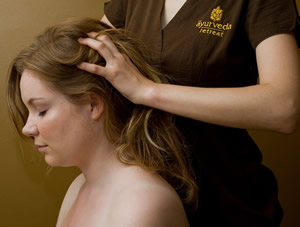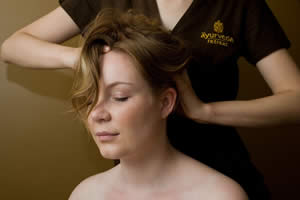Positive Health Online
Your Country

From Shiroabhyangam to the Indian Head Massage
listed in ayurveda, originally published in issue 170 - May 2010
'Shiroabhyangam' is the original name for the Indian head massage. 'Shir' means head, and 'Abhyangam' means oil application. Thus oil application on the head is called as 'Shiroabhyangam' in Sanskrit, a language in which the Ayurvedic classics were initially written, almost 5000 years ago. In its true sense, the Shiroabhyangam, is a complete massage of the head, neck and shoulders.

Importance of Head or 'Shir' in Ayurveda
Out of the three (Heart, Head, and Pelvic region including the excretory and reproductive systems) most important parts of the body, head is the foremost. Head consists of the brain which is the seat of consciousness. It also consists of all the sense organs through which we interact with the outer world.
When Ayurveda and Yoga talk about the concept of rejuvenation they give importance to the functioning of the five senses as a constant part of our ageing process. When they talk about the importance of the daily routine cleansing and detoxifying procedures (Dinacharya), they mainly take into consideration the functioning of sense organs, which if taken care of regularly, makes you stay younger for a much longer time.
According to Ayurveda the five elements i.e. Air; Fire, Water, Earth, and Space intermingle in a dynamic flux with each other to form the human body. The Air and Space element forms the Vata Dosha. ('Dosha' is something which is ready to go out of balance). The Earth and Water elements form the Kapha dosha, and Fire plus Water form the Pitta dosha. Each of these doshas are then subdivided into five different types, depending on their location and function in the human body.
- Ayurveda says that Head is the seat of 'Tarpaka and Bodhaka Kapha', part of the Water and Earth elements residing in the head in the form of the brain, cerebrospinal fluid, salivary glands , saliva, and the palate;
- Head is the seat of 'Alochaka Pitta' i.e. part of the Fire element which resides in the eyes to give us the vision and lustre of our eyes. It is also the seat of 'Bhrajaka Pitta', which gives the glow on your face and skin;
- Besides this the Vata (i.e. the Air & Space elements) which reside in the head in the form of 'Prana Vata' and 'Udana Vata' are mainly responsible for heart rhythm , breathing process, speech, voice, immunity, memory, energy and initiative.
According to Hatha yoga philosophy the human head is compared as the root and the body its branches. The human body is compared to an uprooted tree in the materialistic world, and to see it in the correct form, the roots of the tree should be fixed in the ground. Thus the Headstand or Shirshasana is the king of all Yoga postures mentioned in Hatha Yoga.
In Kundalini yoga the sixth and the seventh chakra (A chakra is a psychic centre that controls all of our physical and mental functioning) i.e. the 'Ajnya '(analogous to the pituitary gland and brain) and 'Sahastradhara' (Lotus with thousand petals, analogous to the brain) lie in the head.
Ayurveda further relates to this and says that as the roots of a tree need water and natural fertilizers to grow and maintain itself , our head also needs the same in the form of different herbal oils that we should massage on the head, and so it prescribes the treatment called as Shiroabhyangam.

Importance of specific oils in Shiroabhyangam:
Ayurveda uses more than 300 herbs to rejuvenate, prevent and cure. The herbs can be taken internally and are also infused in base oils of sesame, coconut and castor in various permutations and combinations. Thus Ayurvedic head oils can consist of a range of a single herb to almost more than twenty herbs, depending on the purpose for it to be used.
The properties of base oils are very important, for example: Coconut base oils are used in hot and humid places, as in southern India where the head needs to be protected from the Sun's heat and needs to be cooler. Coconut being very cold in potency is thus used in base oils for the head.
If we take an example of most of the European countries, especially the UK, which is cold through the year as compared to the human body temperature, sesame based oils are best. Sesame is hot in potency, promotes hair growth, prevents blockages and can enter into minute pores.
Other Ayurvedic oils used for the head to prevent hair loss, hair greying, dandruff etc. with some of their main ingredients (botanical names) are:
- Neelibhringadi – Eclipta alba,Embillica offincinalis, Indigofera tinctoria
- Chempurutyadi – Hibiscus rosaseninsis
- Dhurdhurpatradi – Datura metel
- Bhringraj tailam – Indigofera tinctoria, Eclipta alba, Abrus precatorius
Some of the Head oils used for various other ailments are:
- Chandanadi – reduce stress, & in high blood pressure;
- Asanadi / Dinseladi – sinusitis, rhinitis etc.;
- Ksheerbala – facial palsy, stroke, hemiplagia.
For best results of this treatment, the oil should generally be applied and kept overnight. It can be washed the other day. However for ailments mentioned above, the Ayurvedic physician would be the best person to consult.
Technique
The original Ayurveda classics give no exact reference of a particular technique to be used in Shiroabhyangam. Importance is given to the choice of oil, time for application and time to be kept on the head.
However the classics do mention the vital points (called Marma) on the head and face, which when stimulated in the right manner, clear the blocked energy and produce immediate relaxation These Marma points are the junctures or meeting points, of muscles, ligaments, bones, joints and vessels (nerves, veins and arteries). These junctures form the seat of the Prana, or the vital life force. According to Ayurvedic medicine, there are 107 marma points in the body. The most important for head massage are as follows:
- Adhipati marma - the 'soft spot' or fontanelle, located eight finger widths above the eyebrows in the centre of the skull;
- Simantaka marmas - the spot on the skull 12 finger widths above the eyebrows where the hairs gather in a swirl;
- Krikatika marmas - two points, located on either side of the first cervical vertebra that you can feel behind the head near the point where the neck meets the skull - (occipito-cervical joint);
- Vidhuram marmas - the depressions behind the ears, just behind the ear lobe;
- Shankha marmas - the depressions on the sides of the forehead, between the end of the eyebrows and the hair line, often known as temples.
Strokes
Start by pouring oil on the fontanelle (Adhipati marma) and using both hands (finger tips); spread it out to the sides of the head. Apply oil to the hair swirl i.e. Simantaka marmas, and spread the oil to the temples. Apply oil in the hollow at the back of the neck, just below the skull, and spread it out to the Krikatika marmas, massaging each of them at least for 3- 5 minutes, in a circular motion.
Gently pull the hair follicles in between the massage strokes, starting from the front going behind, as this will increase the blood flow. Move to the Shankha marmas simultaneously on each side, massaging with the index and middle finger, forming a 'o' or '8' for 10 to 15 times;
Gentle tapotments, can also be used behind the skull, depending on stiffness and invigoration needed. Continue slightly downwards and outwards to find the two Siramatrika marmas on either side of the neck (on the trapezius muscle). Massage them, and then move your fingers upwards, seeking the Vidhuram marmas in the depressions behind the ears, and work them.
Adding more oil whenever necessary, continue rubbing around the ear and up towards the temples. You can even pull them upwards, downwards and outwards. The ears (being the main source of the space element - giving the sense of sound) should be completely oiled and massaged thoroughly, as they are often overlooked.
The neck, shoulder blade and upper back can be massaged with a combination of strokes from the thumb, knuckles, forearm and elbow, depending on the stiffness of the trapezius muscle and the pressure your guest would like to have during the treatment.
Ideally it should be carried out for at least 40 - 45 minutes. Time should be divided in between the neck, shoulder and head according to the history the guest gives before the massage.
Benefits (if done with the prescribed oil, regularly)
- Promotes hair growth , making the hair soft in texture;
- Arrests hair fall and hair greying;
- Highly rejuvenating for the senses of sight, smell and hearing;
- Balances the central nervous system;
- Induces sound sleep;
- Used in the management & cure of various ailments such as Facial palsy, Hemiplagia, Rhinitis etc
The Indian Head massage even if taken occasionally, relaxes you and reduces stress immediately, promoting mental clarity and thus inducing your guest/client to visit you once again.
References
1. Charaka Samhita
2. Sushruta samhita
3. Ashtanga Sangraha
4. Ashtanag Hridaya
Acknowledgement Citation
This article was first published in Choice Health & Wellbeing (formerly Today's Therapist) www.choicehealthmag.com
Comments:
-
No Article Comments available